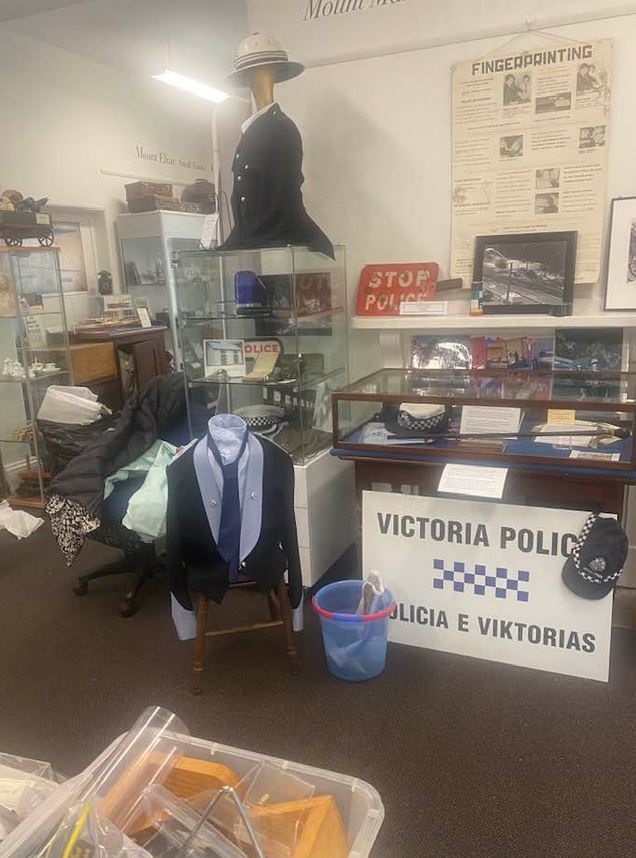Audio Script Back to Audio Tour Index
DW When the train arrived at Mornington in 1889, it greatly expanded the options for holiday makers and daytrippers. The train provided competition for the paddle steamers which had in turn vied with coaches and horse and cart for the holiday transport trade.
The railway also enabled movement of merchandise, farm products and stock. It would carry horses and troops in WWI and in WWII troops who marched to and from Balcombe Army Camp.
Local Historian Val Wilson takes up the story . .
The railway also enabled movement of merchandise, farm products and stock. It would carry horses and troops in WWI and in WWII troops who marched to and from Balcombe Army Camp.
Local Historian Val Wilson takes up the story . .
VW In 1911 a notice in The Mornington Standard announced that a tender for a new station building in Blake Street had been won by a Mr. Maddock of Footscray and that it would be completed in 14 weeks.
This building [pic] occupied the site for 70 years until it was finally demolished to make way for a new shopping centre after the line was officially closed in 1981.
Just imagine people spilling out from the railway station and hurrying home on foot. Or being picked up by members of the Swift family, or the other livery stable proprietors, who had been sitting in their wagons waiting to take passengers to Mt. Martha House or to Dromana.
Picture excited families streaming into Blake Street from the station on their way to a picnic in the Park. And chattering children lining up for an ice cream from the tearooms run by Miss Lyons.
And look at all the wagons waiting to pick up potential buyers at the first auction of Beleura Estate in 1916. Sanders Estate agency and Butlers agency around the corner were well situated for this and many other auctions.
The success of the rail service brought new shops and businesses to Blake Street, although as the years went on, there were many complaints about train delays. The Railway Commissioners seemed to be unwilling to finance the line properly.
The Peninsula Post 1922 ran the following report:
This building [pic] occupied the site for 70 years until it was finally demolished to make way for a new shopping centre after the line was officially closed in 1981.
Just imagine people spilling out from the railway station and hurrying home on foot. Or being picked up by members of the Swift family, or the other livery stable proprietors, who had been sitting in their wagons waiting to take passengers to Mt. Martha House or to Dromana.
Picture excited families streaming into Blake Street from the station on their way to a picnic in the Park. And chattering children lining up for an ice cream from the tearooms run by Miss Lyons.
And look at all the wagons waiting to pick up potential buyers at the first auction of Beleura Estate in 1916. Sanders Estate agency and Butlers agency around the corner were well situated for this and many other auctions.
The success of the rail service brought new shops and businesses to Blake Street, although as the years went on, there were many complaints about train delays. The Railway Commissioners seemed to be unwilling to finance the line properly.
The Peninsula Post 1922 ran the following report:
KW Dozens of new residences have been erected in Mornington. Mr. Sach has recently built commodious shops opposite the railway station, one of which he has occupied as a watchmaker and jewellery shop.
VW Solicitor William Cook was also well patronised.
Miss Lyons sold her confectionery and tearoom business in 1920 to the Misses Beattie who added a library to expand their business. Miss Teague advertised her new dressmaking, millinery and fancy- work business in 1923. New shops were built on the corner in the 1930s, incorporating Butlers agency built in 1890 at number 66, and Wilson and Livock moved their haberdashery and drapery depart ment. Blake Street had become a very busy little area.
There was a ladies’ waiting room, most likely at 3 Blake Street, offering a haven for ladies to wait out of the weather for the train and away from any undesirable elements.
Miss Lyons sold her confectionery and tearoom business in 1920 to the Misses Beattie who added a library to expand their business. Miss Teague advertised her new dressmaking, millinery and fancy- work business in 1923. New shops were built on the corner in the 1930s, incorporating Butlers agency built in 1890 at number 66, and Wilson and Livock moved their haberdashery and drapery depart ment. Blake Street had become a very busy little area.
There was a ladies’ waiting room, most likely at 3 Blake Street, offering a haven for ladies to wait out of the weather for the train and away from any undesirable elements.
Cross over to the next corner.



